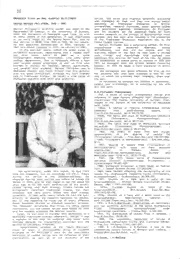
George Norman Philipson, 1916 - 1991 PDF
Preview George Norman Philipson, 1916 - 1991
© Hans Malicky/Austria; download unter www.biologiezentrum.at 10 BRAUERIA (Lunz am See, Austria) 20:10(1993) larvae. His strict and rigorous scientific discipline was impressed on them and they now occupy senior George Norman PHILIPSON, 1916 - 1991 positions as freshwater biologists in British universities, research institutes, water quality bodies Norman Philipson's scientific career was spent in the and government agencies. Collectively, Dr Philipson Department of Zoology in the University of Durham, and his students set the essential basis for much later the University of Newcastle upon Tyne. As with current research on the ecology of Scandinavian river so many others of his generation, it was interrupted systems, and the work also resulted in the production at an early stage by the Second World War, and he of the Freshwater Biological Association Key to the saw service in REME from 1939 to 1946. On his return, Cased Caddis Larvae. he was appointed Demonstrator in 1946, Lecturer in Norman Philipson was a surprising person. On first 1947 and Senior Lecturer in 1970. He retired in 1981. acquaintance he appeared reserved, almost In the post-war years, before the great surge in self-effacing, but that did not equate with his university expansion, departments had a modest staff war-time record or the fact he had been a skilled but what today would be seen as a quite rock climber and mountaineer from boyhood and insupportable teaching commitment. Like many other continued this activity for much of his life. He joined zoology departments, that at Newcastle offered a four two expeditions to remote parts of Iceland in 1970 and year science degree programme as well as first year 1971 as biologist with the British Schools Exploring courses in zoology for medical, dental, agriculture, Society. In 1974 he made a field excursion in Arctic and general arts students. Norman Philipson was a Canada. dedicated teacher and threw himself into this activity His colleagues had great affection for him, as did with his great enthusiasm. Although his main interest his students who also were indebted to him for the was in freshwater biology, he taught a wide range of way in which he promoted their interests, often over Zoological subjects with skill and authority. his own. In retirement he pursued his interest in astronomy, botany and ornithology. He is survived by his wife and two sons. G.N.Philipson: Publications - 1948. A study of certain trichopterous latvae with reference to some factors affecting their distribution. Unpublished PhD thesis, University of Durham. (Copy lodged in the library of the University of Newcastle upon Tyne) 1953a. A method of rearing trichopterous larvae collected from swift-flowing waters. Proc.R.Ent.Soc.Lond, ser.A 28:15-16. - 1953b. The larva and pupa of Hydropsyche instabilis Curtis (Trichoptera, Hydropsychidae). - Proc.R.Ent.Soc.Lond. ser.A 28:17-23. - 1953c. The larva and pupa of Wormaldia subnigra McLachlan (Trichoptera, Philopotamidae). Proc.R.Ent.Soc.Lond. sewr.A 28:57-62. 1954. The effect of water flow and oxygen concentration on six species of caddis fly (Trichoptera) larvae. - Proc.Zool .Soc.Lond 124:547-564. - 1955. Trichoptera in Northumberland. - Ent.Mon.Mag. 91:3. 1957. Records of caddis flies (Trichoptera) in Northumberland, with notes on their seasonal distribution in Plessey Woods. Trans.Nat .Hist .Soc.Northumberland, Durham and Newcastle upon Tyne N.S. 12(3):77-92. 1961. The fifth instar larva of Potamophylax stellatus (Curtis) (Limnephi I idae: Trichoptera). Hydrobiologia 18:321-326. - 1968. Ecological pyramids: a field study at Malham Tarn. - School Science Review 171:262-278. Not surprisingly, under this regime, he had little - 1969. Some factors affecting the net-spinning of the time for research, but he completed his Ph.D. thesis caddis fly, Hydropsyche instabilis Curtis (Trichoptera, during the period of his Demonstratorship, the Hydropsychidae). - Hydrobiologia 34:369-377. research having been carried out before he joined the 1971. Studies on a lake and a pond on the forces in 1939, and he then began to set the stage for Arnarvatnsheidi. - British Schools Exploration Society what was to be the main contribution of his school: Report, 1969 - 1971:144-158. caddis larvae and their biology. Caddis larvae are 1972a. Further studies on lakes of the ecologically important freshwater insects, but their Arnarvatnsheidi. - Brit.Schools Expl .Soc.Rep. taxonomy was very poorly known and their biology 1971-1972:85-102. uncertain. It took some years before he had the opp- - 1972b. Studies on a lake and a small pond on the ortunity to develop the research facilities he needed, Arnarvatnsheidi, West-Central Iceland. but in the meantime he made use of every effective Verh .int. Ver. Theor. An g. Limn. 18:312-319. Heath Robinson devices to simulate mountain streams. - 1974. & B.H.S.Moorhouse. Observations on ventilatory The 'Meccano' structures that filled his office looked and net spinning activities of the genus Hydropsyche improbable, but the caddis larvae were fooled by them Pictet (Trichoptera: Hydropsychidae) under and the systems produced the desired results. experimental conditions. - Freshw.Biol. 4:525-533. Later, he was able to transfer this technology to a - 1975. The distribution of caddis flies in streams. - dedicated freshwater biology laboratory, though it was Proc.R.Ent.Soc. 39:35-36. a sadness to him that its potential was never fully 1978. The undulatory behaviour of larvae of realized because its inauguration coincided with the Hydropsyche pellucidula Curtis and H.siltalai Döhler. decline of university finances. - Proc.2nd Int.Symp.Trich. :241-247. Nevertheless, whether at the 'Heath Robinson1 - 1989, & I.D.Wallace, & B.Wallace. A kew to the stage or later, a distinguished group of students casebearing caddis larvae of Britain and Ireland. - enlarged on Dr Philipson's work on the respiratory Freshw.Biol .Ass.Sei .Publ. no.51. behaviour of caddis larvae and its influence on their distribution, as well as on the taxonomy of the R.B.Clark, I D.Wallace f
